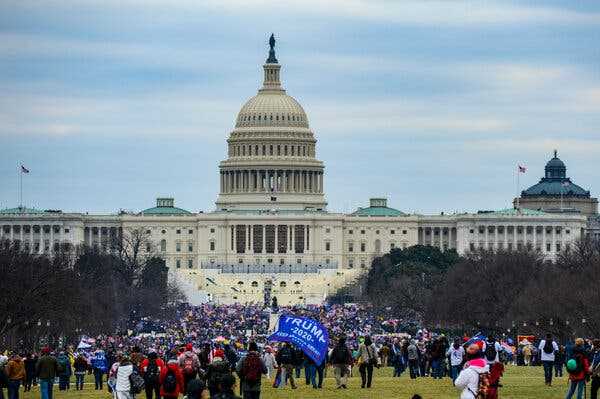Testimony at the seditious conspiracy trial of members of the far-right group demonstrated that they were not deterred by their failure to stop certification of the 2020 election.
-
Send any friend a story
As a subscriber, you have 10 gift articles to give each month. Anyone can read what you share.
Give this articleGive this articleGive this article

Trump supporters moving toward the Capitol on Jan. 6, 2021.
Past dark on Jan. 6, 2021, even after the pro-Trump mob had been chased away and the police had restored some order at the Capitol, members of the Oath Keepers militia kept discussing plans to disrupt the certification of the 2020 election.
Writing on a group text chat, Stewart Rhodes, the organization’s leader, encouraged his members to keep on fighting, restating his belief that President Donald J. Trump had won the race and that Joseph R. Biden Jr. would be an illegitimate president.
Within minutes of those instructions, Kelly Meggs, the top Oath Keeper from Florida, signaled he was ready to keep going.
“We aren’t quitting!!” Mr. Meggs wrote in the chat. “We are reloading!!”
This defiant message was shown on Tuesday to the jury at the trial of five Oath Keepers, including Mr. Rhodes and Mr. Meggs, who are facing charges of seditious conspiracy in connection with the Capitol attack. The message was one of several used by prosecutors in an effort to demonstrate that the group was not deterred from derailing the election even after the violence that erupted at the Capitol on Jan. 6.
Shortly after nightfall that evening, one Oath Keeper asked his fellow members on the group chat what would happen if Congress reconvened to finish the election certification that the mob had interrupted.
Mr. Meggs provided an answer within minutes: “We are going back.”
In another message from around that time, Mr. Meggs told an associate that he and other Oath Keepers had “busted” into the Capitol that day. When the associate wrote that he had hoped to see Speaker Nancy Pelosi’s “head rolling down the front steps” of the building, Mr. Meggs responded, “We looked for her.”
The focus on the aftermath of the Capitol attack came during the fifth week of the trial as the government was nearing the end of its presentation. After showing the jury in Federal District Court in Washington hundreds of internal Oath Keepers messages and putting on nearly 30 witnesses, the prosecution is likely to rest its case this week.
In a surprising move, prosecutors have indicated that they may not call any of the three Oath Keepers who pleaded guilty to seditious conspiracy charges and are cooperating with the government. Members of the group who have pleaded guilty to other, lesser conspiracy charges have appeared as witnesses, and it remains unclear why those who have admitted to sedition may not be asked to testify.
Graydon Young, a former Oath Keeper who pleaded to conspiring to obstruct the election certification, appeared at the trial on Monday, breaking down on the witness stand as he confessed to entering the Capitol in a military-style “stack” of his compatriots.
“I was acting like a traitor,” he told the jury, “someone acting against my own government.”
Mr. Rhodes is likely to be one of the first witnesses called by the defense and could take the stand as early as Friday.
As prosecutors neared the end of their case, they homed in on the stubbornness of Mr. Rhodes and other Oath Keepers who appeared unwilling to give up their fight against Mr. Biden even after the Capitol had been retaken.
On the morning of Jan. 7, for example, one Oath Keeper, Joshua James, wrote to his fellow members, “It’s over. We lose.”
“Like HELL it’s over,” responded Edward Vallejo, a member from Arizona.
Mr. Vallejo, who will face sedition charges at a separate trial next month, was part of a so-called armed “quick reaction force” staged outside of Washington at a hotel in Virginia. He proposed conducting reconnaissance and probing the “defense line” at the Capitol on the morning after the attack, writing to Mr. Rhodes, “We are at WAR.”
Prosecutors also showed the jury messages from some of Mr. Rhodes’s co-defendants — Thomas Caldwell and Jessica Watkins — bragging to their friends or loved ones about storming the Capitol.
On the evening of Jan. 6, Ms. Watkins wrote her partner, “Forced our way into the Senate and House. Got tear gassed and muscled the cops back like Spartans.”
Around the same time, Mr. Caldwell asked an associate, “Did you see us storm the Capitol today?” Then he wrote to another that if the Oath Keepers had been carrying weapons at the building, “I guarantee we would have killed 100 politicians.”
Throughout the trial, the government has offered evidence that Mr. Rhodes, a former Army paratrooper with a law degree from Yale, repeatedly sought to persuade Mr. Trump to invoke the Insurrection Act, a move that he believed would have given his group the standing as a militia to use force of arms in support of Mr. Trump.
On the evening of Jan. 6, Mr. Rhodes was still telling his followers that the president needed to “act as commander in chief.”
The jury learned on Tuesday that after leaving the Capitol grounds, Mr. Rhodes and some of his members went for dinner at an Olive Garden restaurant in Virginia. There, they had a modest feast, prosecutors said, spending more than $400 on their meal.
As the day came to a close, Mr. Rhodes sent a message to his group, urging them not to give up and hoping — again — that Mr. Trump would act quickly and decisively against his enemies.
“Patriots, it was a long day but a day when patriots began to stand,” he wrote. “Stand now or kneel forever. Honor your oaths.”
Source: nytimes.com